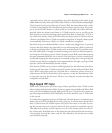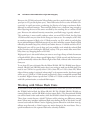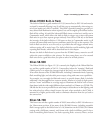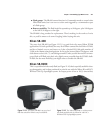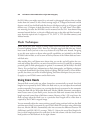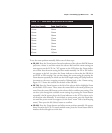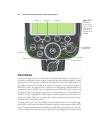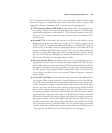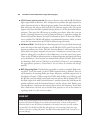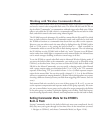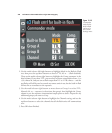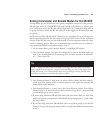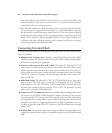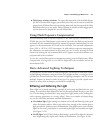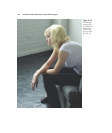for TTL, Manual, and GN settings. Those are the only modes available with that flash
when you’re using it as a Master. However, when the SB-700 is used as a remote flash
triggered by a Master Commander flash, it can operate in Repeating mode.)
■ iTTL Automatic Balanced Fill Flash. In both Matrix and Center-weighted cam-
era exposure modes, the camera and flash balance the exposure so that the main
subject and background are well-exposed. A TTL BL indicator appears on the LCD.
However, if you switch to Spot metering, the flash switches to standard iTTL,
described next.
■ Standard iTTL. In this mode, the exposure is set for the main subject, and the
background exposure is not taken into account. A TTL indicator appears on the
LCD. In either iTTL Automatic Balanced Fill Flash or Standard iTTL modes, if
the full power of the flash is used, the ready light indicator on the flash and in the
camera viewfinder will blink for three seconds. This is your cue that perhaps even
the full power of the flash might not have been enough for proper exposure. If that’s
the case, an EV indicator will display the amount of underexposure (–0.3 to –3.0
EV) on the LCD while the ready light indicator flashes.
■ AA: Auto Aperture flash. An A indicator next to an icon representing a lens open-
ing/aperture is shown on the LCD when this mode is selected. The SB-900 uses a
built-in light sensor to measure the amount of flash illumination reflected back from
the subject, and adjusts the output to produce an appropriate exposure based on
the ISO, aperture, focal length, and flash compensation values set on the D7000.
This setting on the flash can be used with the D7000 in Program or Aperture-
priority modes.
■ A: Non-TTL auto flash. To work with this mode, you must set the SB-900 for its
use using the flash’s (not the camera’s) Custom Settings menu. Press the OK but-
ton in the center of the flash unit’s selector dial for about one second, and when the
Custom Settings menu appears, rotate the selector dial to choose A. Press OK again,
and you can choose from among four variations, Auto Aperture Flash (described
above) with or without monitor pre-flash, or Non-TTL auto flash, with or with-
out monitor pre-flash. (Note that the SB-900 manual calls these options “model-
ing illumination” instead.) In this mode, the SB-900’s sensor measures the flash
illumination reflected back from the subject, and adjusts the output to provide an
appropriate exposure, without the feedback about the aperture setting of the cam-
era that’s used with AA mode. This setting on the flash can be used when the D7000
is set to Aperture-priority or Manual modes. You can use this setting to manually
“bracket” exposures, as adjusting the aperture value of the lens will produce more
or less exposure; the flash has no idea what aperture you’ve changed to.
Chapter 12 ■ Making Light Work for You 425



